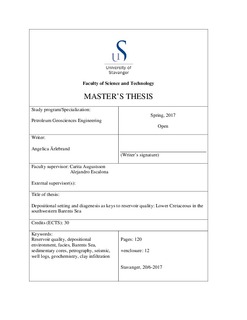| dc.description.abstract | Porosity and permeability are controlled by the interaction of sediment provenance, depositional processes, and diagenesis. This study attempts to determine and predict which role the depositional environment has in enhancing or decreasing the ultimate reservoir quality in four Lower Cretaceous sandstone reservoirs deposited during a period of rifting in a variety of settings in the southwestern Barents Sea. The goal is achieved by linking the distribution of primary textures, compositions, and diagenetic alterations to depositional sandstone facies. Analytical data include sedimentary core logs, petrographic data, XRD, geochemistry, well logs, and seismic data. The core analysis reveals three main depositional settings for the reservoirs; mass-flow, shallow-marine, and deltaic settings, which further are subdivided into 17 rock facies and 6 facies associations based on grain size, degree of bioturbation, and sedimentary structures among others. Petrographic analysis indicates that the mass-flow sandstone, which is characterized by high energy and high rates of sediment supply, has the highest overall reservoir quality with porosity values ranging between 3 and 19 % (avg. 13 %). The high porosity is attributed to a generally good hydraulic sorting, non-pervasive carbonate cementation that inhibited compaction and created porosity through later dissolution, and a moderate mechanical clay infiltration that resulted in clay cutanes on grain rims and further in the precipitation of chlorite, which inhibited quartz growth. Higher porosity in the distal (basin-floor fan) than in the proximal (slope channel) mass-flow facies is considered a result of longer transportation paths and sediment reworking that led to higher compositional maturity of the distal sandstone, whereas abundant sedimentary rock fragments in the proximal facies enhanced mechanical compaction. Deltaic sandstone is characterized by moderate to fluctuating energy and sediment supply and proved ideal conditions for mechanical clay infiltration. The reservoir quality varies (porosities of 2-18 %, avg. 8 %) due to varying amounts of infiltrated clay. Sandstone with moderate clay infiltration proved higher reservoir quality, whereas extensive clay infiltration occluded pore-spaces and increased the mechanical compactability of the sandstone. Lowest reservoir quality (porosities of 1-12 %, avg. 7 %) has the shallow-marine sandstone, which represent an environment of low energy and low rates of sediment supply. Fine-grained laminae and interstitial matrix caused porosity reduction, which further was deteriorated by bioturbation. Abundant mica and feldspar grains in the shallow-marine sandstone, partly a result of the provenance, and deep burial resulted in extensive illitization that further decreased the porosity and permeability. | nb_NO |
